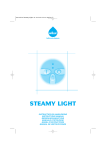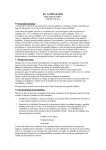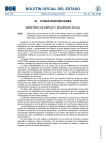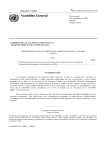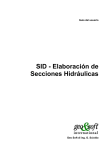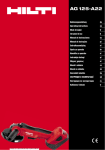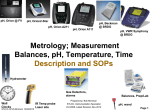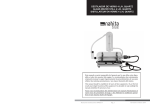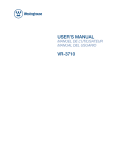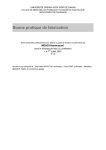Download EQUIPO DE DESTILACIÓN DISTILLATION EQUIPMENT
Transcript
Page 24 9 +0.91 +0.77 +0.63 +0.48 +0.33 +0.17 0.00 -0.18 -0.36 -0.54 -0.73 -0.93 -1.13 8 +0.85 +.073 +0.60 +0.46 +0.31 +0.16 0.00 -0.17 -0.34 -0.51 -0.70 -0.89 -1.08 14ºC 15ºC 16ºC 17ºC 18ºC 19ºC 20ºC 21ºC 22ºC 23ºC 24ºC 25ºC 26ºC 11 +1.04 +1.89 +0.72 +0.55 +0.37 +0.19 0.00 -0.19 -0.39 -0.60 -0.81 -1.02 -1.24 10 +0.97 +0.83 +0.67 +0.51 +0.35 +0.18 0.00 -0.19 -0.37 -0.57 -0.77 -0.97 -1.18 Volumetric alcoholic grade, % vol. Instruction manual 1500x220 -1.30 -1.07 -0.85 -0.63 -0.41 -0.20 0.00 +0.20 +0.40 +0.59 +.077 +0.95 +1.12 12 -1.36 -1.13 -0.89 -0.66 -0.44 -0.22 0.00 +0.21 +0.42 +0.62 +.082 +1.02 +1.20 13 -1.43 -1.19 -0.94 -0.70 -0.47 -0.23 0.00 +0.23 +0.45 +0.67 +0.88 +1.09 +1.29 14 -1.50 -1.25 -0.99 -0.74 -0.49 -0.25 0.00 +0.24 +0.48 +0.71 +0.94 +1.16 +1.39 15 -1.57 -1.31 -1.04 -0.78 -0.52 -0.26 0.00 +0.25 +0.51 +0.75 +1.00 1.24 1.49 16 -1.65 -1.37 -1.10 -0.82 -0.55 -0.28 0.00 +0.27 +0.53 +0.80 +1.06 +1.32 +1.58 17 -1.73 -1.43 -1.15 -0.86 -057 -0.29 0.00 +0.28 +0.56 +0.84 +1.12 +1.40 +1.68 18 -1.80 -1.49 -1.20 -0.90 -0.60 -0.30 0.00 +0.30 +0.59 +0.89 +1.19 +1.48 +1.78 19 -1.87 -1.56 -1.25 -0.93 -0.62 -0.31 0.00 +0.31 +0.62 +0.94 +1.25 +156 +1.88 20 ENGLISH Version 2 October-07 EQUIPO DE DESTILACIÓN DISTILLATION EQUIPMENT Este manual es parte inseparable del aparato por lo que debe estar disponible a todos los usuarios del equipo. Le recomendamos leer atentamente el presente manual y seguir rigurosamente los procedimientos de uso para obtener las máximas prestaciones y una mayor duración del mismo. This manual should be available for all users of these equipments. To get the best results and a higher duration of this equipment it is advisable to read carefully this manual and follow the processes of use. Revisión 2 Octubre-07 Manual de instrucciones 1500x220 Pág. 1 CASTELLANO Gracias por elegir un equipo de destilación NAHITA, compuesto de vidrio borosilicato esmerilado 29/32. Su alta calidad le permitirá disponer de este instrumento por muchos años, no obstante, le recomendamos leer atentamente el presente manual y seguir rigurosamente los procedimientos de uso para obtener las máximas prestaciones y una mayor duración del mismo. ÍNDICE DE IDIOMAS Castellano Inglés 2-13 14-24 ÍNDICE DE CONTENIDOS 1. FUNDAMENTOS TEÓRICOS 2. DESCRIPCIÓN 3. MONTAJE 4. RECOMENDACIONES 5. PRÁCTICAS 2 3 5 6 7 LEA DETALLADAMENTE ESTE MANUAL DE INSTRUCCIONES ANTES DE OPERAR CON ESTE EQUIPO CON EL FIN DE OBTENER LAS MÁXIMAS PRESTACIONES Y UNA MAYOR DURACIÓN DEL MISMO. 1. FUNDAMENTOS TEÓRICOS ENGLISH 3. Procedure In the case of young or sparkling wines, remove firstly the carbonic gas. Stir 250 mL of wine in a flask of 500 mL. The interior of the flask must be previously siliconated with 3 drops of a solution of water soluble silicone at 1%; when the flask is dry, add the wine. 3. Distillation: Add 250 mL of wine into a volumetric flask and check the temperature. Pour the wine in a spherical distilling flask with some small pieces of porcelain and add 10 mL of calcium hydroxide to turn the wine alkaline. Add some drops of silicone to avoid froth formation. Collect the distilled product into the 250 mL volumetric flask; the flask must contain 10 mL of pure water in which the bent distillation adapter is submerged. Distil at least 200 mL of wine and add water up to 250 mL. Pour the volume into a 250 mL measuring cylinder. Wait 1 min and then check the temperature. Remove the thermometer, submerge the alcoholometer and leave to stand at least 1 min. Take note of at least 3 readings of the alcoholic grade. The scale of the alcoholometer must be read just under the meniscus. Note: Use a magnifying glass to read better the alcoholometer scale. 4. Calculations and results The volumetric alcoholic grade is expressed in % of volume at 20 ºC with 2 decimal numbers; the second decimal number must be approximated to 0 or 5. As the volumetric alcoholic grade depends on temperature, determinations must be always performed at 20 ºC. If the temperature is not 20 ºC, readings must be corrected by using the following chart: La destilación es una técnica empleada para la purificación de líquidos mediante la separación de un líquido impurezas no volátiles o la separación de dos líquidos volátiles de distinto punto de ebullición. Es una técnica en la que el líquido se somete a los siguientes pasos: - Evaporación por calentamiento - Condensación del vapor producido - Recogida del condensado en recipiente aparte Se conoce como punto de ebullición de un líquido puro la temperatura a la cual la presión de vapor de dicho líquido se iguala a la presión externa. De este modo, el punto de ebullición es una constante física que caracteriza a un determinado líquido pero que varía con la presión. Si se trata de una mezcla de líquidos, el punto de ebullición se alcanza cuando la suma de las presiones parciales de vapor de cada líquido es igual a la presión externa. En un proceso de destilación en el laboratorio, el líquido a destilar se calienta en un matraz de fondo redondo (matraz de destilación). Cuando se alcanza el punto de ebullición, se forman abundantes burbujas de vapor que van ascendiendo. Parte del vapor se condensa durante la ascensión y vuelve a caer, pero la mayor parte entra en el refrigerante donde se enfría y condensa por efecto del flujo de agua fría que circula por la camisa Pág. 2 Manual de instrucciones 1500x220 Revisión 2 Octubre-07 Version 2 October-07 Instruction manual 1500x220 Page 23 ENGLISH CASTELLANO - pH indicator paper 4. Precautions Be extremely careful with the vapours; always wear safety glasses and avoid burns. Ethanol is very flammable. Keep always this product away from flames. The sulphuric acid is very corrosive. 5. Procedure Put a round bottom flask in cold water and add 30 mL of ethanol, 50 g of ammonium acetate and 50 mL of sulphuric acid. Keep the flask in cold water during operation. Once reaction is finished, assembly the distillation equipment; connect the condenser with a tap to make the water flow through the jacket and warm gently the spherical flask, so as distillation is performed slowly. Collect the distillation produced until temperature reaches 80-85 ºC and stop distillation. Look up in a chart of organic compounds boiling points and deduce which are the components of the initial mixture and which is the component that remains in the distilling flask. Prepare two saturated solutions of Na2CO3 and CaCl2. exterior del refrigerante. El producto condensado se canaliza a un matraz Erlenmeyer o recipiente similar a través de un terminal acodado. Si en la solución inicial existían sustancias no volátiles, quedarán como residuo en el matraz de destilación, mientras que si se partía de una mezcla de líquidos, el producto destilado será más rico en el componente más volátil. Dentro de la técnica de la destilación, se pueden diferenciar dos tipos principales: Pour the distilled product into a separating funnel and wash it with the carbonate solution; mix gently and let the two phases (aqueous and organic) separate. Keep washing the solution until the pH of the upper phase is not acid (check the pH with indicator paper). To remove the rests of carbonate, wash the solution with calcium chloride and remove the aqueous phase. Pour the liquid that remains in the funnel into a porcelain dish with magnesium sulphate or any other dehydrating agent and let act for half an hour. Cover the dish with a watch glass. Wash, let dry and weight an Erlenmeyer flask with a cork stopper and filter the dish content. Weight the liquid obtained that will be mostly ethyl acetate. 6. Calculations and results Calculate the performance of the process. Practice 4: Determination of volumetric alcoholic grade 1. Principle The volumetric alcoholic grade is the number of litres of ethyl alcohol (ethanol) and equivalents (methanol, 2,3-butanediol) contained in 100 litres of wine; both volumes must be measured at 20 ºC and expressed in volumetric alcoholic grades (%vol) with a precision of 0.1%. 2. Material and reagents - Distillation equipment - Hydrometer (alcoholometer) - Heating mantle - Calcium hydroxide - Round bottom flask, 1 L - Phenolphthalein - Measuring flask, 250 mL - Silicone - Measuring cylinder, 250 mL Page 22 Instruction manual 1500x220 Version 2 October-07 Destilación simple Es el caso más sencillo de destilación. El montaje consta de un matraz esférico (de destilación), una pieza acodada, un refrigerante, un terminal acodado y diverso material necesario para el montaje del equipo (clips, soportes, pinzas, etc.) y las posteriores determinaciones a realizar. Esta técnica se utiliza fundamentalmente para eliminar un soluto no volátil o para separar una mezcla de líquidos con bastante diferencia en su punto de ebullición. Como norma general cualquier mezcla de dos componentes que hiervan con una diferencia de unos 80 ºC pueden separarse por medio de una destilación sencilla. El componente de punto de ebullición mas bajo, el más volátil, destilará con mayor rapidez, y la primera fracción del destilado será muy rica en él. El componente de punto de ebullición más alto, el menos volátil, será el componente principal de la última fracción del destilado. Destilación fraccionada La principal diferencia con el equipo de destilación simple es que, en este caso, entre el matraz esférico o de destilación y la pieza acodada se acopla una columna de fraccionamiento. Este tipo de destilación es un recurso por el cual se realizan una serie de minúsculas separaciones en una única operación continua. La columna de fraccionamiento proporciona una gran superficie para que los vapores ascendentes y el condensado descendente intercambien calor, de manera que a lo largo de la columna tienen lugar numerosas evaporaciones y condensaciones parciales. El componente de menor punto de ebullición continúa alcanzando su temperatura de ebullición hasta que se la mezcla separa completamente. Entonces, la temperatura se eleva hasta el punto de ebullición del componente menos volátil de forma que éste empieza a llegar al refrigerante. Este cambio de temperatura tiene un efecto enriquecedor del vapor en el componente más volátil, de la misma forma que lo conseguirían múltiples destilaciones. 2. DESCRIPCIÓN Los equipos de destilación Nahita están compuesto por material de vidrio borosilicato con uniones esmeriladas 29/32: - Equipo de destilación simple>>Ref 15000220 - Equipo de destilación fraccionada>> Ref 15001220 Revisión 2, Octubre-07 Manual de instrucciones 1500x220 Pág. 3 CASTELLANO Figura 1 J C B H D E F G A I HEAT POW ER ON OFF Letra A B C D E F J LES MANT ING L 655 MODE ING WORK Referencia 18015220 18117001 11215251 18127001 18230250 63226229 72064100 Descripción Matraz esférico de destilación, 250 mL Pieza acodada de 75º Refrigerante Liebig, 250 mm Terminal acodado, 100 mm Columna Vigreux (Equipo destilación fraccionada) Clips de POM para uniones esmeriladas Termómetro -10/110 ºC Los siguientes accesorios, que no se incluyen con el equipo, son necesarios para un buen montaje: Letra G H I Descripción Soporte pie plato Pinza para refrigerantes Manta calefactora, 250 mL Pág. 4 Manual de instrucciones 1500x220 Revisión 2 Octubre-07 ENGLISH Pour 35 mL of acetone and 35 mL of water into the distilling spherical flask and add some small pieces of porcelain. Open the tap to make the water flow through the condenser jacket and warm uniformly the distilling flask. The boiling point of the acetone is lower than the water's so the acetone will reach its boiling point first. The acetone vapour will move upward the fractionation column; a heat interchange will take place between the ascendant vapour and the descendant condensed liquid. The acetone is collected in an Erlenmeyer flask. When the boiling point of the water is reached, it will begin to distil and again, a heat interchange will take place. It is very important to change the Erlenmeyer flask when the temperature is around 85 ºC. Thus assuring that acetone distillation is finished and water distillation does not yet begin. Measure the obtained acetone and water volume. 5. Calculations and results Make a chart and a graphic with the data of temperature and time. Write the boiling points obtained for the acetone and water. Practice 3: Preparation of ethyl acetate 1. Objectives To obtain an organic compound To combine different laboratory basic techniques 2. Principle The action of a carboxylic acid over an alcohol produces an ester and water as shown by the following formula: CH3COOC2H5(l) + H2O(l) CH3COOH(l) + C2H5OH(l) This reaction is slow and the presence of an equilibrium makes impossible a good performance. The sulphuric acid is used as a catalyser and as a dehydrating agent, thus the equilibrium is displaced towards the right producing a large quantity of ester (ethyl acetate). Esters have a nice smell and are usually volatile. One of the techniques used in this practice is the distillation, which is used to separate mixtures of liquids. Separation is based on the different boiling points of the components of the mixture. When the mixture is warmed the liquids evaporate and condense later. The more volatile component is the first obtained. 3. Material and reagents - Distillation equipment - Ammonium acetate - Beaker or Erlenmeyer flask - Ethanol 96º - Thermometer - H2SO4 - Concentrated sulphuric acid - Separating funnel - Na2CO3 - Sodium carbonate - Watch glass - MgSO4 - Magnesium sulphate (anhydrous) - Two stands with retort ring and clamps - CaCl2 Calcium chloride Version 2 October-07 Instruction manual 1500x220 Page 21 ENGLISH Fraccional distillation Practice 2: Separation of a mixture of acetone and water 1. Objectives To understand the bases and applications of the fractional distillation To compare the efficiency of the fractional distillation against that of simple distillation 2. Principle It is a fractional distillation technique that consists of separating two liquids whose boiling points differ in less that 80 ºC. This technique allows a better and more efficient separation of the liquids than successive distillations, thanks to a fractionation column. Warming the flask produces the evaporation of the solution. This vapour, during its travel along the column is condensed. Due to the ascendant vapours a heat interchange is produced between them and the descendant liquid and the more volatile component reaches the condenser and finally the collecting flask. The less volatile component, however, remains inside the distilling flask. 3. Material and reagents - Round bottom spherical flask - Thermometer - Vigreux column - Bent distillation adapter - 75º bent connecting adapter - 2 Small Erlenmeyer flasks - Condenser - Heating mantle - Measuring cylinder - Acetone - Water - Clamps, stand, rubber tubing, porcelain, grease, insulating tape 4. Procedure Assembly the fractional distillation equipment as shown in figure 4: CASTELLANO Material de laboratorio útil para realizar una destilación - Matraz Erlenmeyer - Mechero Bunsen - Soporte pie trípode - Tela metálica - Probeta - Vaselina Nota: Los accesorios expuestos están indicados para la configuración estándar, si desea usar un matraz de mayor capacidad u otras medidas de soportes, mantas calefactoras etc. consulte nuestra página web (www.auxilab.com). 3. MONTAJE MUY IMPORTANTE: Antes de realizar el montaje, unte todas las uniones esmeriladas con vaselina. Con la ayuda de los soportes y pinzas coloque el equipo según se indica en el dibujo siguiente: F J C figure 4 F B D E H F 0 100 BOM EX 200 300 400 500 600 G 0 ml 100 900 800 700 600 500 A 400 I S TLE MAN TING EL 655 HEA MOD POWE R ON OFF WORKIN H G S TLE MAN TING EL 655 HEA MOD POWE R Page 20 Instruction manual 1500x220 Version 2 October-07 Revisión 2, Octubre-07 ON OFF G WORKIN Manual de instrucciones 1500x220 Pág. 5 CASTELLANO (A) Matraz esférico de destilación: De boca esmerilada, en él se vierte la solución a destilar. En el caso del equipo de destilación simple, este matraz va sujeto a un soporte metálico (G) mediante unas pinzas (H); en el equipo de destilación fraccionada, la pinza (H) sujeta la columna Vigreux (E). Este matraz se introduce en la manta calefactora (I). (B) Pieza acodada de 75º: También conocida como cabeza de destilación, va unida por un lado al matraz de destilación (A) y por otro al refrigerante (C); en el caso del equipo de destilación fraccionada estará unida a la columna Vigreux (E) y al refrigerante (C). En su parte superior, la pieza acodada presenta una cabeza roscada con un orificio por el que se introduce un termómetro para controlar en todo momento la temperatura de trabajo. El bulbo del termómetro debe quedar justo por debajo de la rama lateral de la pieza acodada, de manera que esté completamente bañado por la corriente de vapores y la medida de temperatura sea correcta. (C) Refrigerante: Va unido a la pieza acodada de 75º (B) y sujeto a un soporte metálico (G) mediante unas pinzas (H). A lo largo del refrigerante existen dos zonas: una interna por donde pasa y se condensa el vapor proveniente del matraz de destilación, y otra externa por donde circula el agua de refrigeración. (D) Terminal acodado: Une el refrigerante con el matraz Erlenmeyer o el recipiente donde se recoge la muestra destilada. (E) Columna Vigreux. (F) Clips: Todos los componentes de vidrio del equipo se unen entre sí mediante clips para uniones esmeriladas fabricados en polioximetileno (POM). 4. RECOMENDACIONES Antes de comenzar la destilación asegúrese de: Que ha elegido un matraz cuya capacidad esté de acuerdo con la cantidad de producto a destilar. El equipo de destilación Nahita se suministra con un matraz esférico de 250 mL; en nuestro catálogo podrá encontrar matraces de otras capacidades. Nota: El matraz no debe llenarse más de las 2/3 partes de su capacidad, ni tampoco debe ser excesivamente grande. Que ha untado con vaselina todas las juntas esmeriladas. Que ha añadido algunos trocitos de material poroso (porcelana) al matraz de destilación. Casi todos los líquidos tienden a sobrecalentarse en cierta extensión; este estado metaestable se interrumpe periódicamente porque se emiten vapores repentina y bruscamente. Para evitar esto se añaden 2 ó 3 trozos de material poroso al matraz de destilación antes de comenzar el calentamiento. Los poros de estas sustancias proporcionan sitios donde se pueden formar núcleos de burbujas que inducen así la ebullición uniforme. Si en cualquier instante la temperatura desciende por debajo del punto de ebullición, el líquido llena los poros de la sustancia que regulaba la ebullición y pierde toda su eficacia. Antes de añadir un trocito nuevo de material poroso, el líquido debe dejarse enfriar hasta una temperatura netamente inferior a la de ebullición; si se añade a un líquido sobreca- Pág. 6 Manual de instrucciones 1500x220 Revisión 2 Octubre-07 ENGLISH 5. PRACTIES Simple distillation Practice 1: Purification of methyl alcohol 1. Objectives To understand the bases and applications of the simple distillation To learn to assembly a simple distillation equipment 2. Principle It is an easy technique that consists of separating the impurities of a liquid by heating it. When the liquid reaches its boiling point, distillation begins; the generated vapour is condensed and collected while impurities remain inside the distilling flask. 3. Material and reagents - Round bottom spherical flask - Erlenmeyer flask, 250 mL - 75º bent connecting adapter - Heating mantle or Bunsen burner - Condenser - Measuring cylinder - Thermometer - Methyl alcohol - Bent distillation adapter - Clamps, stand, rubber tubing, porcelain, grease, insulating tape 4. Procedure Assembly the simple distillation equipment according to figure 3. All the ground joints must be well greased. Pour 50 mL of alcohol inside the spherical or distilling flask. Warm the flask uniformly until the liquid reaches its figure 3 boiling point. The generated vapour passes through a condenser where it cools and condenses; the liquid is collected into an Erlenmeyer flask. The non volatile particles or dissolved impurities do not boil and remain inside the spherical distilling flask; thus, the distilled product collected in the Erlenmeyer flask is pure alcohol. The thermometer situated at the bent connecting adapter indicates the temperature at which the boiling point of the alcohol is reached. This temperature must stay constant during all the distillation. At the beginning the temperature must be checked every 2 min and then every minute. When the liquid begins to boil, the temperature must be checked every 3 min. 5. Calculation and results Write a chart with the data of time (min) and temperature (ºC) Indicate the temperature at which the alcohol is distilled. 0 100 BOM EX 200 300 400 500 600 Version 2 October-07 Instruction manual 1500x220 Page 19 0 ml 100 900 800 700 600 500 400 ENGLISH CASTELLANO nal region through which the vapour from the distilling flask passes and condenses, and the external region through which the cooling water flows. (D) Bent distillation adapter: It connects the condenser with the Erlenmeyer flask or the recipient to collect the distilled product. (E) Vigreux cloumn (F) Clips: All the components are joined and fixed together by means of polyoxymethylene (POM) clips included with the equipment (see fig. 2). lentado se puede desencadenar la ebullición de una forma violentísima. Que ha unido todas las piezas de vidrio con los clips incluidos en el equipo. Tenga cuidado de que no existan tensiones, pues el material de vidrio podría llegar a romperse. Que ha conectado el refrigerante correctamente con el flujo de agua; el tubo de goma debe estar colocado correctamente en la entrada y salida de agua. Que el calentamiento de la solución a destilar sea lo mas uniforme posible; para ello, es conveniente utilizar una manta calefactora. Esto es especialmente necesario si el líquido es inflamable. Que ha regulado la fuente de calor de forma que la velocidad de destilación sea de aproximadamente una gota por segundo. Si la velocidad es mayor no da tiempo a que se establezca el equilibrio líquido/vapor y la destilación no es buena. Si por el contrario la velocidad es muy lenta, el bulbo del termómetro estará siempre cubierto por una gota de líquido condensado y la medida de temperatura no será correcta. No calentar un matraz vacío, podría romperse. Que hace circular una corriente suave de agua por el refrigerante, uniendo la entrada de éste al grifo mediante una goma. El agua que sale del refrigerante por su parte superior se conducirá a una pila o desagüe mediante otra goma. 4. RECOMENDATIONS Before starting with the distillation process make sure that: The capacity of the distilling flask is correct and enough to contain the volume to be distilled. The Nahita distillation equipments include a distilling flask of 250 mL, please consult our catalogue to find flasks of other capacities. Note: The flask must not be filled over 2/3 its capacity, neither must be excessively big. All the ground joints are perfectly greased. Some small pieces of porcelain have been added to the distilling flask. Almost all liquids tend to overheat; this metastable state is interrupted periodically because vapours are emitted suddenly. To avoid this, 2 or 3 pieces of porcelain must be added to the distilling flask before starting heating. The pores of this substance provide places for groups of bubbles to form thus inducing a uniform boiling. If the temperature decreases under the boiling point, the liquid fills the pores of the substance loosing all its effect and efficiency. Then, the liquid must be let to cool under a temperature below the boiling point before adding a new piece of porcelain; if it is added to an overheated liquid it can produce a violent boiling. All the components are joined together by means of the clips included with the equipment. Make sure that there are no tension forces that will cause breakage of the glass components. The condenser is connected to the water flow; the rubber tubing must be well connected to the water inlet/outlet. It is convenient to use a heating mantle for a uniform warming of the flask. This is especially necessary in case of flammable liquids. The heat source is adjusted so as the distillation speed is approximately 1 drop per second. If speed is higher there is no time to establish the liquid/vapour equilibrium and distillation is no good. If speed is too slow, the bulb of the thermometer will always be covered by drop of condensed liquid and temperature readings will not be correct. Do not heat the flask if it is empty; it could break. The water flows gently through the condenser. Using a rubber or latex tubing, connect the water inlet to a tap and the water outlet to a sink. Page 18 Instruction manual 1500x220 Version 2 October-07 5. PRÁCTICAS Destilación simple Práctica 1: Purificación del alcohol de quemar 1. Objetivos Comprender el fundamento y aplicaciones de la destilación simple Aprender a realizar el montaje de un equipo de destilación simple 2. Fundamentos Es una técnica de destilación simple, que consiste en la separación de las impurezas no volátiles de un líquido mediante su calentamiento hasta la ebullición. Cuando el líquido llega a su punto de ebullición se evapora y posteriormente pasa de nuevo a estado líquido permaneciendo las impurezas no volátiles en el matraz de fondo redondo. 3. Material y reactivos - Matraz esférico de fondo redondo - Pieza acodada 75º - Refrigerante - Termómetro - Terminal acodado - Matraz Erlenmeyer, 250 mL - Manta calefactora o mechero Bunsen - Pinzas, soporte, gomas, porcelana, vaselina, cinta aislante - Probeta - Alcohol comercial Revisión 2, Octubre-07 Manual de instrucciones 1500x220 Pág. 7 CASTELLANO 4. Procedimiento Montar el aparato de destilación simple según el esquema que indica la figura 3; antes del montaje, todas las uniones esmeriladas deben untarse con vaselina. Añadir 50 mL de alcohol comercial en el matraz de destilación. Calentar el matraz uniformemente hasta que la temperatura del líquido alcance su punto de ebullición. El vapor formado pasa por el interior del refrigerante donde se condensa por efecto del frío; el líquido condensado se recoge en el matraz Erlemneyer. Las sustancias no volátiles o impurezas disueltas en el alcohol no hierven sino que permanecen en el matraz de destilación. Por tanto el líquido destilado recogido en el Erlemmeyer es puro, es decir, se recogen los mL de alcohol puro contenido en los 50 mL de alcohol comercial inicial. El termómetro situado en la parte superior de la pieza acodada indica la temperatura a la que se alcanza el punto de ebullición del alcohol, permaneciendo constante hasta la completa destilación. Desde el inicio del calentamiento se debe controlar la temperatura cada 2 min al principio y cada minuto después. En el momento en que el líquido comienza a destilar, la temperatura se debe controlar cada 3 min. 3. ASEMBLY VERY IMPORTANT: Before assembling the different components, all the ground joints must be greased. Using the stands and clamps, assembly the different parts as indicated in the next figure: F J C F B D E figure 3 H F G A H I S TLE MAN TING EL 655 HEA MOD POWE R ON OFF G WORKIN (A) Distilling spherical flask: With a ground joint at the neck; it contains the solution 0 100 BOM EX 200 300 400 500 600 0 ml 100 900 800 700 600 500 400 5. Cálculos y resultados Realizar una tabla con los datos de tiempo (min) y temperatura (ºC) Indicar a qué temperatura destila el alcohol Pág. 8 Manual de instrucciones 1500x220 Revisión 2 Octubre-07 to be distilled. In case of the simple distillation equipment, the flask is fixed to the metallic stand (G) by means of a clamp (H). In the fractional distillation equipment, the clamp holds the Vigreux column (E). The distilling flask is put inside the heating mantle (I). (B) Bent connecting adapter, 75º: It is also known as distillation head and presents two ground joints, one of them is connected to the flask (A) and the other to the condenser (C). In the fractional distillation equipment, the bent connecting adapter is joined to the Vigreux column (E) and the condenser (C). A thermometer is introduced through the upper part of the bent connecting adapter; the bulb of the thermometer must stay under the lateral arm of the adapter so as it is in complete contact with the vapour flow and then, the temperature readings will be correct. (C) Condenser: It is joined to the bent connecting adapter (B) and fixed to a metallic stand (G) by means of a clamp (H). Along the condenser there are two regions: the interVersion 2 October-07 Instruction manual 1500x220 Page 17 ENGLISH Figure 1 J C B H D E F G A I HEAT POW ER ON OFF LES MANT ING L 655 MODE ING WORK The following accessories are not included but are necessary for a good assembly: Letter Description G Retort stand H Clamp for condensers I Heating mantle, 250 mL Useful labware to perform a distillation: - Erlenmeyer flask - Bunsen burner - Tripod stand - Gauze iron wire - Measuring cylinder - Grease for ground joints Note: All the accessories mentioned above are indicated for a standard configuration; to use a spherical flask with higher capacity or any other size for stands, heating mantles etc. please visit our web site (www.auxilab.com). Page 16 Instruction manual 1500x220 Version 2 October-07 CASTELLANO Destilación fraccionada Práctica 2: Separación de una mezcla de acetona y agua 1. Objetivos Comprender el fundamento y aplicaciones de la destilación fraccionada Comparar la eficacia de la destilación fraccionada frente a la destilación simple 2. Fundamentos Esta práctica es una destilación fraccionada que consiste en la separación de dos líqui cuya diferencia en sus puntos de ebullición es menor de 80 ºC. Con este tipo de desdos tilación se consigue una separación más eficaz de ambos líquidos que si se realizaran destilaciones simples sucesivas. Esta mayor eficacia se consigue gracias a la columna de fraccionamiento. El calentamiento del matraz de destilación produce la evaporación de la mezcla inicial. Este vapor producido, durante su recorrido por la columna de fraccionamiento, se condensa pasando de nuevo a estado líquido. Por el efecto de arrastre de los vapores ascendentes el componente más volátil consigue llegar al refrigerante y finalmente al matraz colector. El componente menos volátil en cambio no sufre este efecto de arrastre y cae de nuevo al matraz de destilación. 3. Material y reactivos - Matraz esférico de fondo redondo - 2 Matraces Erlenmeyer pequeños - Columna Vigreux - Manta calefactora - Pieza acodada 75º - Probeta - Refrigerante - Acetona - Termómetro - Terminal acodado - Agua - Pinzas, soporte, gomas, porcelana, vaselina, cinta aislante 4. Procedimiento Montar el aparato de destilación según se indica en la figura 4: Añadir al matraz de destilación 35 mL de acetona y 35 mL de agua medidos con una probeta, y unos trocitos de porcelana. Abrir el grifo para activar el flujo de agua en el refrigerante y calentar el matraz de destilación. El punto de ebullición de la acetona es más bajo que el del agua por lo que este componente será el primero que comience a evaporarse. El vapor ascenderá por la columna de fraccionamiento y se producirá el intercambio de calor entre el vapor ascendente y el líquido condensado descendente. La acetona destilada se recoge en el matraz Erlenmeyer. La destilación del agua comenzará cuando se alcance su punto de ebullición, produciéndose el mismo intercambio de calor en la columna de fraccionamiento. Se debe cambiar el matraz Erlenmeyer alrededor de los 85 ºC, para asegurarnos de que la acetona ha terminado de destilar y todavía no ha empezado a destilar el agua. Medir el volumen obtenido de agua y de acetona. Revisión 2, Octubre-07 Manual de instrucciones 1500x220 Pág. 9 CASTELLANO figura 4 0 100 BOM 200 EX 300 400 500 600 0 ml 100 900 800 700 600 500 400 ES MANTL 655 TING HEA MODEL POWE R ON OFF NG WORKI 5. Cálculos y resultados Realizar una tabla y una gráfica con los datos de temperatura y tiempo Anotar los puntos de ebullición obtenidos de la acetona y del agua Práctica 3: Preparación de acetato de etilo 1. Objetivos Obtener un compuesto orgánico. Combinar varias técnicas básicas de laboratorio. 2. Fundamentos La acción de un ácido carboxílico sobre un alcohol origina un éster y agua como se puede ver en la siguiente reacción: CH3COOH(l) + C2H5OH(l) CH3COOC2H5(l) + H2O(l) Esta reacción es lenta y además se establece un equilibrio que hace que el rendimiento no sea alto. Para desplazar el equilibrio hacia la derecha se utiliza ácido sulfúrico que actúa como agente catalizador y deshidratante, produciéndose así una mayor cantidad de éster (acetato de etilo en este caso). Los ésteres tienen un olor agradable y generalmente son volátiles. Una de las técnicas aplicadas en esta práctica es la destilación, utilizada para separar mezclas de líquidos. La separación se basa en los diferentes puntos de ebullición de los componentes de la mezcla. Al calentar dicha mezcla, los componentes se evaporan para condensarse posteriormente. El componente más volátil es el primero que se obtiene. 3. Materiales y reactivos - Equipo de destilación Pág. 10 Manual de instrucciones 1500x220 Revisión 2 Octubre-07 ENGLISH the most volatile component. Distillation techniques can be divided into different types: Simple distillation This is the simplest type. The assembly is composed of a spherical flask (distilling flask), a bent connecting adapter, a condenser, a bent distilling adapter and other material necessary for the assembly of the distillation equipment and later determinations. The simple distillation technique is used to remove non volatile particles and separate a mixture of liquids with a high difference in their boiling points. As a general rule any mixture of liquids with a difference in their boiling points of at least 80 ºC can be separated by simple distillation. The component with the lowest boiling point, it means the most volatile, boils faster and the first fraction of the distilled product is very rich in this component. The component with the highest boiling point, it means the less volatile, will be the main component of the last distilled fraction. Fractional distillation In this case, a fractionation column is connected between the distilling flask and the bent connecting adapter. In this type of distillation a series of minuscule separations are performed in a unique and continuous operation. The fractionation column provides a large surface for the ascendant vapours and the descendant condensed product to interchange heat, thus making possible that numerous partial evaporations and condensations take place all along the column. The component with the lowest boiling point keeps reaching its boiling temperature until the mixture is completely separated. Then, the temperature is increased up to the boiling point of the less volatile component so as it can reach the condenser. This change of temperature makes the distilled product richer in the most volatile component, having the same effect as multiple distillations. 2. DESCRIPTION The Nahita distillation equipments are made of borosilicate glass with 29/32 ground joints: - Simple distillation equipment >> Cod. 15000220. - Fractional distillation equipment >> Cod. 15001220. Letter Code Description A 18015220 Spherical distilling flask, 250 mL B 18117001 Bent connecting adapter, 75º C 11215251 Liebig condenser, 250 mm D 18127001 Bent distillation adapter, 100 mm E 18230250 Vigreux column (only fractional distillation equipment) F 63226229 POM clips for ground joints J 72064100 Thermometer -10/110 ºC Version 2 October-07 Instruction manual 1500x220 Page 15 ENGLISH Thank you for choosing a Nahita distillation equipment made of borosilicate glass and with ground joints of 29/32. Its high quality will permit you to enjoy this equipment for years. We highly recommend to read thoroughly this manual to get the best results and a higher duration of the equipment. INDEX OF LANGUAGES Castellano Inglés 2-13 14-24 INDEX OF CONTENTS 1. THEORETICAL FOUNDATIONS 2. DESCRIPTION 3. ASSEMBLY 4. ADVICES 5. PRACTICES 15 16 17 18 19 TO GET THE BEST RESULTS AND A HIGHER DURATION OF THE EQUIPMENT IT IS ADVISABLE TO READ THOROUGHLY THIS MANUAL BEFORE OPERATING WITH THE EQUIPMENT. 1. THEORETICAL FOUNDATIONS Distillation is a technique used to purify liquids by removing the non volatile impurities or by separating two liquids with different boiling points. In this technique the liquid is passed through different steps: - Evaporation by heating - Condensation of the vapour - Collection of the condensed vapour in a separate recipient The boiling point of a liquid is the temperature at which the vapour pressure of the liquid matches the environmental pressure. In the case of a mixture of liquids, the boiling point is reached when the sum of the partial vapour pressures of each liquid matches the environmental pressure. In a process of distillation in the laboratory, the liquid is warmed up in a spherical flask (distilling flask). When the boiling point is reached, numerous bubbles of vapour are formed and move upward the flask. A part of the vapour is condensed while ascending and falls again into the distilling flask but the most of the vapour goes into the condenser and there condenses thanks to the cold water that flows through the external jacket of the condenser. The condensed liquid is transported to an Erlenmeyer flask or any other recipient through a bent distillation adapter. The non volatile particles remain as wastes in the distilling flask; if the initial solution is a mixture of liquids, then the vapour will be richer in Page 14 Instruction manual 1500x220 Version 2 October-07 CASTELLANO - Vaso o matraz Erlenmeyer - Termómetro - Etanol 96º - H2SO4 - Ácido sulfúrico concentrado - Embudo de decantación - Na2CO3 - Carbonato sódico - Vidrio de reloj - CaCl2 - Cloruro cálcico - 2 soportes con aro y pinzas - MgSO4 - Sulfato magnésico (anhidro) - Acetato amónico - Papel indicador de pH 4. Precauciones Extremar la precaución con los vapores, llevar en todo momento gafas de seguridad; asimismo se deben evitar las quemaduras. El etanol es muy inflamable. Alejar las botellas de las llamas. El ácido sulfúrico es muy corrosivo. 5. Procedimiento Colocar el matraz de destilación dentro de agua fría y añadir en él 30 mL de etanol, 50 g de acetato amónico y 50 mL de ácido sulfúrico. Mantener el matraz dentro de agua fría durante la operación. Terminada la reacción montar el aparato de destilación. Conectar el refrigerante con el flujo de agua y calentar el matraz con cuidado, de modo que la destilación sea lenta. Recoger el producto destilado hasta los 80-85 ºC y parar la destilación. Consultar con una tabla de puntos de ebullición de productos orgánicos y deducir qué contiene la mezcla inicial y cuál es el componente que queda como residuo. Preparar dos disoluciones saturadas de Na2CO3 y de CaCl2. Pasar el producto destilado a un embudo de decantación y lavar con la disolución de carbonato, agitando suavemente y dejando separar las dos fases (acuosa y orgánica). Seguir lavando hasta que la fase superior no de pH ácido (comprobar el pH con papel indicador). Para eliminar los restos de carbonato lavar con la solución de cloruro cálcico y eliminar la fase acuosa. Añadir el líquido que queda en el embudo a una cápsula con sulfato de magnesio u otro agente deshidratante y dejar actuar durante media hora, tapando la cápsula con un vidrio de reloj. Lavar, secar y pesar un Erlenmeyer con tapón de corcho y filtrar en él el contenido de la cápsula. Pesar el líquido obtenido que será en su mayor parte acetato de etilo. 6. Cálculos y resultados Calcular el rendimiento de la obtención Práctica 4: Determinación del título alcohométrico 1. Fundamentos El título alcohométrico o grado alcohólico volumétrico es el número de litros de alcohol etílico (etanol) y de sus homólogos (metanol, alcoholes superiores, 2.3-butanodiol) contenidos en 100 litros de vino, medidos ambos volúmenes a 20 ºC. Se expresa en grados alcohólicos volumétricos (% vol.) con una precisión de 0.1%. Revisión 2, Octubre-07 Manual de instrucciones 1500x220 Pág. 11 Pág. 12 Manual de instrucciones 1500x220 Revisión 2 Octubre-07 Revisión 2, Octubre-07 -1.87 -1.80 -1.73 -1.65 -1.57 -1.50 -1.43 -1.36 -1.30 -1.24 -1.18 -1.08 26ºC -1.13 -1.56 -1.49 -1.43 -1.37 -1.31 -1.25 -1.19 -1.13 -1.07 -1.02 -0.97 -0.89 25ºC -0.93 -1.25 -1.20 -1.15 -1.10 -1.04 -0.99 -0.94 -0.89 -0.85 -0.81 -0.77 -0.70 24ºC -0.73 -0.93 -0.90 -0.86 -0.82 -0.78 -0.74 -0.70 -0.66 -0.63 -0.60 -0.57 -0.51 23ºC -0.54 -0.62 -0.60 -057 -0.55 -0.52 -0.49 -0.47 -0.44 -0.41 -0.39 -0.37 -0.34 22ºC -0.36 -0.31 -0.30 -0.29 -0.28 -0.26 -0.25 -0.23 -0.22 -0.20 -0.19 -0.19 -0.17 21ºC -0.18 0.00 +0.31 +0.30 0.00 0.00 +0.28 +0.27 0.00 0.00 +0.25 +0.24 0.00 0.00 +0.23 +0.21 0.00 0.00 +0.20 +0.19 0.00 0.00 +0.18 0.00 20ºC 0.00 +0.16 19ºC +0.17 +0.62 +0.59 +0.56 +0.53 +0.51 +0.48 +0.45 +0.42 +0.40 +0.37 +0.35 +0.31 18ºC +0.33 +0.94 +0.89 +0.84 +0.80 +0.75 +0.71 +0.67 +0.62 +0.59 +0.55 +0.51 +0.46 17ºC +0.48 +1.25 +1.19 +1.12 +1.06 +1.00 +0.94 +0.88 +.082 +.077 +0.72 +0.67 +0.60 16ºC +0.63 +1.48 +1.40 +1.32 1.24 +1.16 +1.09 +1.02 +0.95 +1.89 +0.83 +.073 15ºC +0.77 +1.78 +1.68 +1.58 1.49 +1.39 +1.29 +1.20 +1.12 +1.04 +0.97 +0.91 +0.85 14ºC 20 19 18 17 16 15 14 13 12 11 10 9 8 5. Cálculos y resultados El grado alcohólico volumétrico se expresa en % vol a 20 ºC con 2 cifras decimales, debiendo aproximarse el 2º decimal a 0 ó 5. Como el grado alcohólico volumétrico sufre variaciones con los cambios de temperatura, siempre que sea posible las determinaciones deben realizarse a 20 ºC. En su defecto, es necesario corregir del valor obtenido utilizando la siguiente tabla. Grado alcohólico volumétrico, % vol. Nota: Ayúdese de una lupa para realizar las lecturas. +156 CASTELLANO +1.88 CASTELLANO 2. Materiales y reactivos - Equipo de destilación - Manta calefactora - Matraz de fondo redondo, 1 L - Matraz aforado, 250 mL - Probeta, 250 mL - Densímetro (alcohómetro) - Hidróxido de calcio - Fenolftaleína - Silicona 3. Procedimiento En el caso de vinos jóvenes o espumosos, eliminar previamente el gas carbónico. Para ello, agitar 250 mL de vino en un matraz de 500 mL con el interior previamente siliconado con tres gotas de solución de silicona soluble en agua al 1%; una vez el matraz está bien seco, añadir el vino. 4. Destilación: Medir 250 mL de vino en un matraz aforado y anotar la temperatura. Pasar el vino a un matraz de destilación que contenga unos fragmentos de materia porosa. Añadir 10 mL de hidróxido de calcio para alcalinizar el vino (la materia colorante del vino debe virar a la alcalinidad). Añadir unas gotas de silicona para evitar la formación de espuma. Recoger el producto destilado en el mismo matraz aforado de 250 mL que contenga unos 10 mL de agua pura, en la que debe sumergirse el terminal acodado. Destilar por lo menos 200 mL de vino y añadir agua hasta los 250 mL. Pasar el destilado a una probeta de 250 mL y medir la temperatura al cabo de 1 mi. Retirar el termómetro e introducir el alcohómetro. Dejar reposar durante al menos 1 min y realizar la lectura por la parte inferior del menisco. Se han de realizar por lo menos 3 lecturas del grado alcohólico. Manual de instrucciones 1500x220 Pág. 13














